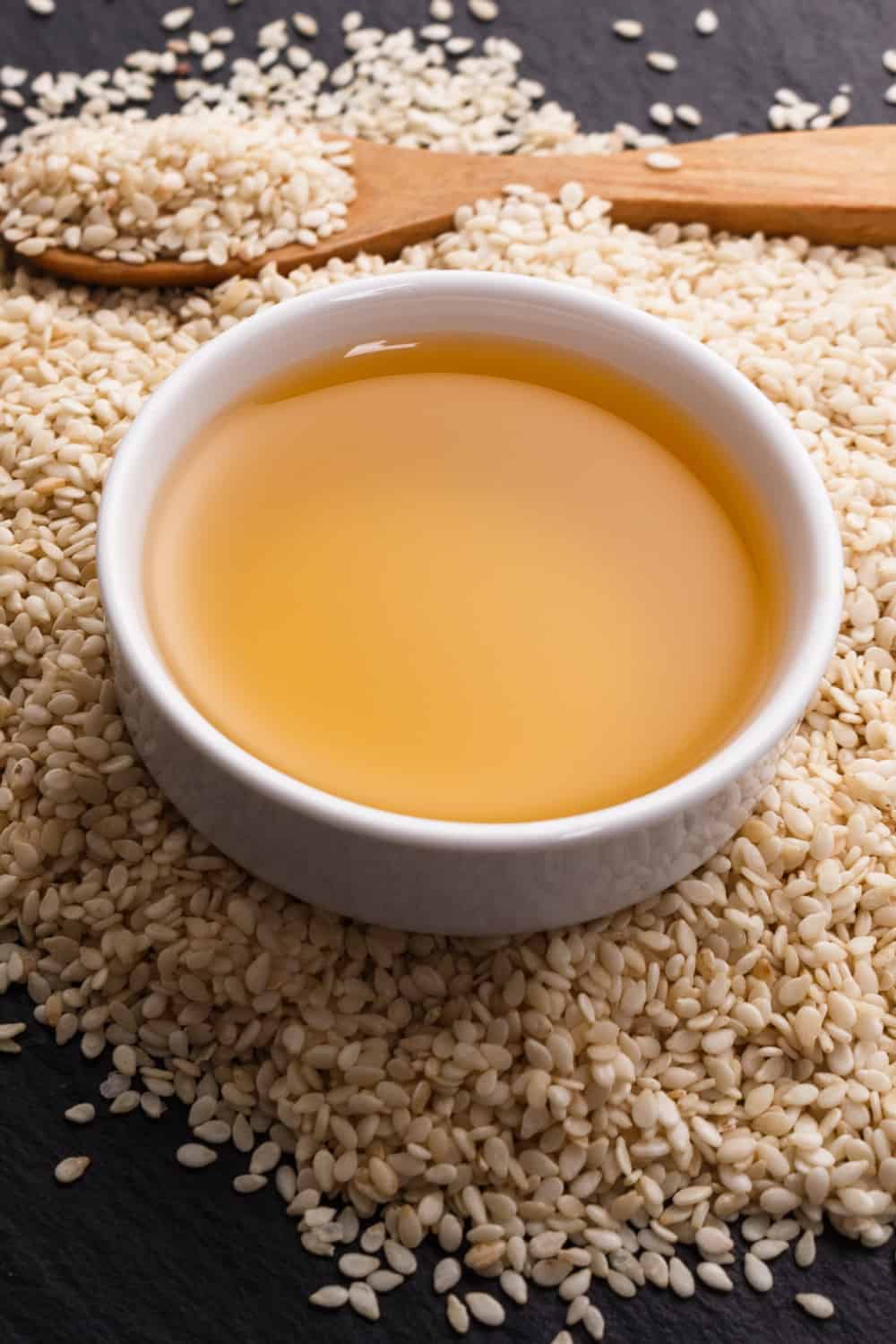
Many people wonder does sesame oil go bad after a while. The fact is that it won’t last forever, but the question is, how long does sesame oil last. It primarily depends on its quality and the way of storing.
You don’t need it for daily use, but it helps to have such a product in the kitchen. Therefore, it is valuable to know more about the subject. Let’s see.
Table of Contents
Does Sesame Oil Go Bad?
Unfortunately, sesame oil can go bad since, like all unrefined oils, it primarily contains unsaturated fats. These facts make it highly valuable in a human diet but are also directly responsible for why this product goes rancid.
As soon as you open a bottle, the oxidation process and triglyceride hydrolysis begin due to air, moisture, light, and bacteria exposure. As a result, your oil will start degrading into free fatty acids and glycerol.
You can help antioxidants, including phenols, to slow this breakdown by storing this product correctly. Unfortunately, that is only a way to slow the process, not to stop it forever.
After a while, sesame oil will become dark and start smelling unpleasant and tasting harsh. Keep in mind that it doesn’t happen suddenly but is a long process that lasts for months.
Please, remember that rancidification is an ongoing process. When it just starts, the smell or taste might not be of top quality but still good enough to use. But as time goes by, the oil will only get worse.
How Long Does Sesame Oil Last?

Basically, no one can give you an exact sesame oil lifespan. It depends on a few crucial factors, including:
- Sesame seed initial quality before its processing starts
- The period of sesame seed storing after milling
- Sesame seed storing conditions
- Possible blending with other oils
- How long it will take to transport the oil in a shipping container
- How much time will you need to spend your supplies
- Packaging quality
Keep in mind that the sesame oil you buy in the local store is already a few months, even years old. In other words, the product quality is much worse than at the moment its production.
|
Sesame oil |
||
|
Sesame oil |
Pantry | Fridge |
| Unopened packaging | 1 to 2 years |
2 + years |
|
Opened packaging |
6 to 8 months |
1 to 2 years |
Like any other oil, this product comes with a best-by date. It is a rough estimate of required product quality when stored adequately. However, it probably won’t go rancid for several additional months.
So, you can store unopened packaging for up to two years in a pantry or even longer when it stays safe in your refrigerator.
The best option you have is to store your oil in the pantry and use it within six months after breaking the seal. If you keep it in a fridge, you can use it for a few more months without thinking of possible quality deterioration.
Tips to Tell if Sesame Oil Has Gone Bad

Sesame oil is a highly beneficial ingredient but can go bad quickly if stored inappropriately. The first signs of spoilage include:
Color
Cold-pressed sesame oil is pale yellow, while Indian sesame oil is a bit darker, almost golden. The toasted product is even darker. When this oil becomes rancid, it will turn dark brown.
Texture
If you spot clouds on the oil surface and any changes in its clarity, it has probably become rancid.
Smell
Rancid sesame oil will lose its nutty aroma and start smelling pungent and sour.
Taste
Most people don’t want to try smelly oil with clear signs of rancidness, but you can do that to be sure if there is a chance to use it or not. Spoiled sesame oil tastes bitter and sour, but you can’t precisely determine the spoilage levels.
Mold
Unlike other oil types, you will never see mold in sesame oil, even in the case of its quality deterioration.
Tips to Store Sesame Oil
The best way to store any oil, including sesame oil, is to keep it in the original packaging until deciding to use it. Once opened, it is necessary to pour it into an airtight container to prevent oxidation and consequently rancidness.
Whatever way of storing you choose, it is needed to keep the packaging away from direct sunlight and heat sources.
Quality
The crucial prerequisite for the oil to last long is to buy a high-quality product. Conscientious small-batch producers use only top-quality sesame seeds and keep their equipment clean.
Be wise and never refill an old sesame oil bottle with a new one. Also, don’t use the same container for new oil after spending the old one without thorough cleaning. Otherwise, even traces of more aged oil’s drops may spoil the new product.
Packaging
Always choose smaller packaging and non-transparent and dark, preferably green or blue bottles to protect the product from heat and light. That way, less air will enter the bottle once you start using your sesame oil, and you will spend the whole amount before it goes bad.
Large tins of sesame oil seem like an excellent and economical solution, but they are too expensive if you need to throw out half of the content after becoming rancid.
Kitchen cabinet and pantry
Since light and heat negatively affect the sesame oil quality, you should store it in a cold and dark place. The most convenient options you have at your disposal are a kitchen cabinet and pantry provided that you can ensure that the temperature doesn’t vary too much.
Tightly closed oil will last about six months stored this way if you avoid leaving the container unsealed on the counter. Always use the amount you need and then place the rest in a safe place.
Fridge
Keeping sesame oil in the fridge will prolong its life, and the product will keep its nuttiness, color, and texture for a more extended period. This particular oil contains up to 42% PUFAs (Polyunsaturated fatty acid), making it susceptible to oxidation.
Since it goes rancid faster than other oils, it is wise to store it in the fridge, especially if you don’t use it regularly. Never put the packaging in a refrigerator door because the temperature significantly fluctuates there.
On the other hand, keeping sesame oil in the refrigerator has its disadvantages. For example, it will quickly absorb other food odor and become rotten-smelled.
Another disadvantage is its reaction at low temperatures, and it will become solidify and dense after a while. In such a case, you need to let it sit at least 15 minutes at room temperature to return to the liquid state before using it.
Freezer
In general, there is no need to freeze sesame oil. It will change its texture at temperatures below 25 F (- 4 C) and become thick. As a result, you won’t be able to pour it out of the bottle without thawing it. It can be pretty impractical if you use this product regularly.
The Risk of Consuming an Expired Sesame Oil

Fresh sesame oil is a desired nutritional supplement full of valuable antioxidants. In general, it is not advisable to consume rancid sesame oil because it can cause nausea and vomiting. Plus, its taste is really awful.
On the other hand, it can’t harm you too much and don’t expect severe problems if you eat it. Only in rare cases is it possible to face any issue with potentially toxic compound development.
Can You Freeze Sesame Oil?
You can find a few sesame oil varieties on the market, including:
- Cold-pressed sesame oil – It is a quality product made without preservatives and chemicals. This traditional extraction method doesn’t include heat.
- Light (plain, white) sesame oil – This neutrally flavored product is taken from raw, untoasted sesame seeds. Since its smoke point is high, you can use this oil type for roasting or shallow frying.
- Dark (toasted, Asian) sesame oil – This brown to dark, red-brown oil is produced from toasted seeds. Thanks to its low smoke point, rich nutty flavor, and intense aroma, you can use it when preparing fried rice, salad dressings, and noodles.
- Blended sesame oil – Nowadays, it is pretty common to mix two different oils. For example, producers add sesame oil to olive oil to decrease prices and make their products more affordable.
No matter which sesame oil type you have, it is not recommended to freeze it since its freezing temperature is pretty low. Additionally, it will take too much time to solidify.
On the other hand, once hardened, it will be hard to cut a piece. It makes this way of storing quite impractical. One of the solutions is to freeze oil in ice cube trays and use cubes when necessary. It is an excellent option for both mass-produced and homemade sesame oils.
Summary
Guidelines for sesame oil storing significantly vary. It can last for long if you keep it appropriately in the pantry or fridge, but it is crucial to check your product occasionally. Only after smelling and tasting can you be sure that it is still usable.